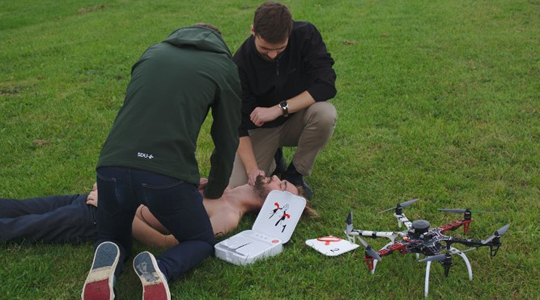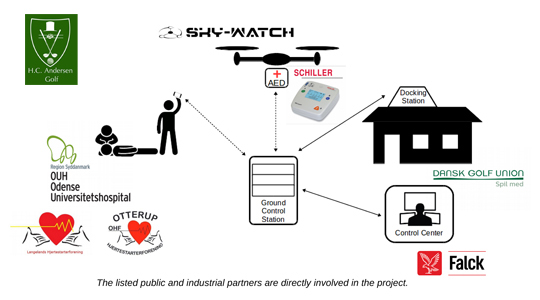AED Drone started out as a student semester project at the MSc. Specialization in Drone Technology at SDU UAS Center.
The objective was to develop an autonomous AED delivery system for drones in case of cardiac arrest at golf courses. The AED is requested via a smartphone app, and is immediately delivered to the GPS position of the smartphone.
H.C. Andersen Golf in Bogense at Northern Funen offered to be test area.
Why AED Delivery Drones?
Every day on average four persons suffer from a cardiac arrest in public places in Denmark. Each minute to defibrillation reduces the probability of survival by approx. 10%. Drones can deliver an AED faster than anyone.

Why Golf Courses?
Denmark has 152,000 active golf players, of which 45% are above 60 years and therefore at increased risk of cardiac arrests. In 2016 the news reported two cardiac arrests at golf courses in Denmark.
The average size of a golf course is 68 ha. and the typical distance to an AED is 500-2000m. The manual delivery time of a defibrillator to a cardiac arrest is up to 4-5 min. today.
Attaching the AED to an autonomous drone could reduce the delivery time to 2-3 min., increasing the chances of survival significantly.
Cooperation
By cooperation with public and industrial partners, the students have direct access to "real life" knowledge and experience.
Knowing the current practices and conditions for use of AED's are critical in order to develop a new viable drone-based delivery system.
The external partners are directly involved in the project by taking part in the teaching and the students also had the chance to visit Falck and Sky-Watch, who also contributed by developing the drone platform that the students works with.
Partners are listed in the model:

Test Flights
The students test the AED Drone delivery system at SDU UAS Test Center in HCA Airport.
The test flights implies that the drone responds to the AED request sent from a smartphone and that the drone autonomously fly to the GPS position of the smartphone.
Test video show how the AED Drone responds to the request sent by the person on the field in the safety vest.
Next step
Obtaining permission for fully autonomous BVLOS flight (Beyond Visual Line of Sight) at H.C. Andersens Golf Course.
The tests conducted at the golf cours will help improving the UAS reliability, thereby enable use in more populated areas.
Results from the AED Drone project will be applicable to the research project Free the Drones (FreeD), that is also working on developing technologies for drones to fly BVLOS.
Media
Drones fly with defibrillators, 10 October, 2017, www.fyens.dk (in Danish)
Drones with defibrillators, News broadcast, 10 October, 2017, Tv2Fyn.dk
In the future drones fly with defibrillators, 10 October, 2017, DR1 National News broadcast
The help to cardiac arrests arrives with a drone, 10. October, Jyllands-Posten (in Danish)
Contact
Kristian Husum Terkildsen, SDU UAS Center
.png?h=330&iar=0&w=770&hash=B73A237FD4998545C49AEC2D80B33366)